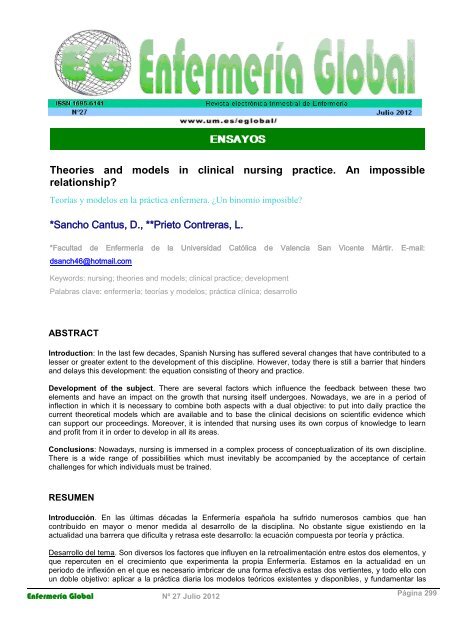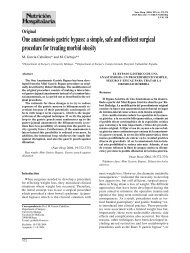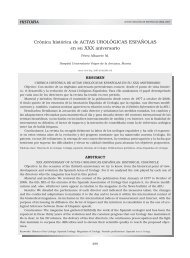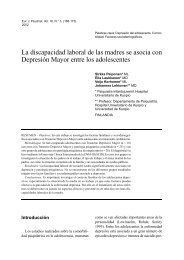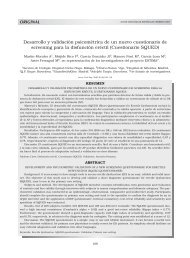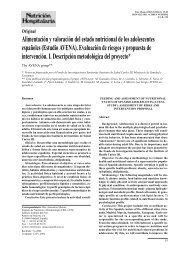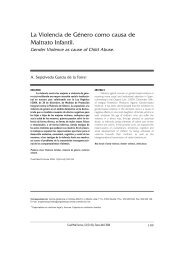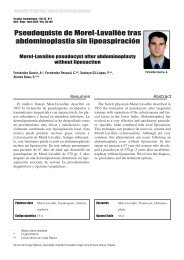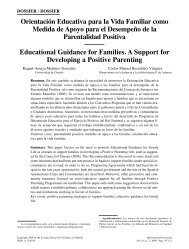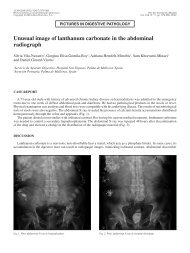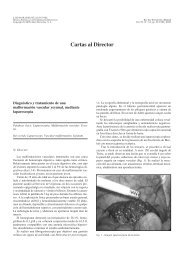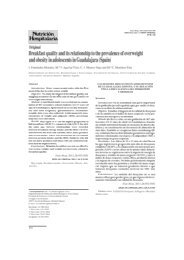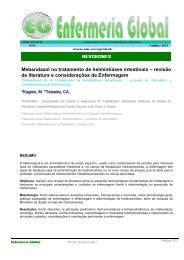Theories and models in clinical nursing practice. An impossible ...
Theories and models in clinical nursing practice. An impossible ...
Theories and models in clinical nursing practice. An impossible ...
You also want an ePaper? Increase the reach of your titles
YUMPU automatically turns print PDFs into web optimized ePapers that Google loves.
Enfermería Global Nº 27 Julio 2012<br />
ENSAYOS<br />
<strong>Theories</strong> <strong>and</strong> <strong>models</strong> <strong>in</strong> cl<strong>in</strong>ical nurs<strong>in</strong>g <strong>practice</strong>. <strong>An</strong> <strong>impossible</strong><br />
relationship?<br />
Teorías y modelos en la práctica enfermera. ¿Un b<strong>in</strong>omio imposible?<br />
*Sancho Cantus, D., **Prieto Contreras, L.<br />
*Facultad de Enfermería de la Universidad Católica de Valencia San Vicente Mártir. E-mail:<br />
dsanch46@hotmail.com<br />
Keywords: nurs<strong>in</strong>g; theories <strong>and</strong> <strong>models</strong>; cl<strong>in</strong>ical <strong>practice</strong>; development<br />
Palabras clave: enfermería; teorías y modelos; práctica clínica; desarrollo<br />
ABSTRACT<br />
Introduction: In the last few decades, Spanish Nurs<strong>in</strong>g has suffered several changes that have contributed to a<br />
lesser or greater extent to the development of this discipl<strong>in</strong>e. However, today there is still a barrier that h<strong>in</strong>ders<br />
<strong>and</strong> delays this development: the equation consist<strong>in</strong>g of theory <strong>and</strong> <strong>practice</strong>.<br />
Development of the subject. There are several factors which <strong>in</strong>fluence the feedback between these two<br />
elements <strong>and</strong> have an impact on the growth that nurs<strong>in</strong>g itself undergoes. Nowadays, we are <strong>in</strong> a period of<br />
<strong>in</strong>flection <strong>in</strong> which it is necessary to comb<strong>in</strong>e both aspects with a dual objective: to put <strong>in</strong>to daily <strong>practice</strong> the<br />
current theoretical <strong>models</strong> which are available <strong>and</strong> to base the cl<strong>in</strong>ical decisions on scientific evidence which<br />
can support our proceed<strong>in</strong>gs. Moreover, it is <strong>in</strong>tended that nurs<strong>in</strong>g uses its own corpus of knowledge to learn<br />
<strong>and</strong> profit from it <strong>in</strong> order to develop <strong>in</strong> all its areas.<br />
Conclusions: Nowadays, nurs<strong>in</strong>g is immersed <strong>in</strong> a complex process of conceptualization of its own discipl<strong>in</strong>e.<br />
There is a wide range of possibilities which must <strong>in</strong>evitably be accompanied by the acceptance of certa<strong>in</strong><br />
challenges for which <strong>in</strong>dividuals must be tra<strong>in</strong>ed.<br />
RESUMEN<br />
Introducción. En las últimas décadas la Enfermería española ha sufrido numerosos cambios que han<br />
contribuido en mayor o menor medida al desarrollo de la discipl<strong>in</strong>a. No obstante sigue existiendo en la<br />
actualidad una barrera que dificulta y retrasa este desarrollo: la ecuación compuesta por teoría y práctica.<br />
Desarrollo del tema. Son diversos los factores que <strong>in</strong>fluyen en la retroalimentación entre estos dos elementos, y<br />
que repercuten en el crecimiento que experimenta la propia Enfermería. Estamos en la actualidad en un<br />
periodo de <strong>in</strong>flexión en el que es necesario imbricar de una forma efectiva estas dos vertientes, y todo ello con<br />
un doble objetivo: aplicar a la práctica diaria los modelos teóricos existentes y disponibles, y fundamentar las<br />
Pág<strong>in</strong>a 299
decisiones clínicas en evidencias científicas que respalden nuestras actuaciones. Con todo ello se pretende<br />
que la Enfermería utilice su corpus propio de conocimientos y sea capaz de nutrirse y de aprovecharlos para su<br />
desarrollo en todos sus ámbitos competenciales.<br />
Conclusiones: En estos momentos la Enfermería se halla <strong>in</strong>mersa en un complejo proceso de<br />
reconceptualización de la propia discipl<strong>in</strong>a, y se abre un abanico de posibilidades que deberán ir acompañadas<br />
<strong>in</strong>evitablemente de la asunción de ciertos desafíos para los cuales será necesario estar correctamente<br />
formados.<br />
INTRODUCTION<br />
We tend to def<strong>in</strong>e the Nurs<strong>in</strong>g <strong>practice</strong> as a science, <strong>in</strong> the sense of acquir<strong>in</strong>g knowledge<br />
through observation <strong>and</strong> experimentation, with the <strong>practice</strong> based <strong>in</strong> the scientific evidence. It<br />
is also considered an art <strong>and</strong> philosophy, compatible with this scientific conception [1,2] .<br />
There is a direct <strong>and</strong> immediate relationship between the b<strong>in</strong>omial theory <strong>and</strong> <strong>practice</strong>, <strong>and</strong><br />
this is a question that is be<strong>in</strong>g widely discussed today as a reference po<strong>in</strong>t to place<br />
epistemologically Nurs<strong>in</strong>g [2,3]<br />
In the development of our profession, there are factors related with the theory <strong>and</strong> the<br />
<strong>practice</strong> that can be problematic <strong>and</strong> need to be thought, for example, the chronic<br />
detachment of these two aspects (some authors [4,5] talk about a divorce between knowledge<br />
<strong>and</strong> <strong>practice</strong>), <strong>and</strong> the reality versus the idea of Nurs<strong>in</strong>g.<br />
In this sense, it is essential to unify theory <strong>and</strong> <strong>practice</strong> to be able to base both <strong>in</strong> the<br />
objective reality <strong>and</strong> scientific evidences. There are many authors nowadays that st<strong>and</strong> up for<br />
consider<strong>in</strong>g Nurs<strong>in</strong>g <strong>practice</strong> as a key piece along the theory for the development of nurses [4-<br />
6] .The gap between theory <strong>and</strong> <strong>practice</strong>, between researcher <strong>and</strong> researched subject<br />
produces a descontextualiz<strong>in</strong>g effect that disables the actions form the po<strong>in</strong>t of view of<br />
efficiency essential [7]<br />
There is a lack of epistemological concision <strong>in</strong> Nurs<strong>in</strong>g lead<strong>in</strong>g to overlapp<strong>in</strong>g or to the<br />
<strong>in</strong>correct location of the discipl<strong>in</strong>e <strong>in</strong> the scientific taxonomy. The ma<strong>in</strong> challenge presented is<br />
the professional <strong>and</strong> scientific consolidation, which is <strong>in</strong>timately l<strong>in</strong>ked with the<br />
epistemological <strong>in</strong>def<strong>in</strong>ition <strong>and</strong> the adoption of methods that contradict the discipl<strong>in</strong>e<br />
essence’s object [8,9] .<br />
The Evidence-based Nurs<strong>in</strong>g (EBN) makes us th<strong>in</strong>k over the epistemological <strong>and</strong><br />
methodological references <strong>in</strong> which the cl<strong>in</strong>ical <strong>practice</strong> is based.<br />
Colliere [1] stated: tell me what knowledge you apply <strong>and</strong> I will tell you what type of care you<br />
give. It is necessary the research of th<strong>in</strong>k<strong>in</strong>g scenarios around the nurs<strong>in</strong>g profession <strong>and</strong> the<br />
<strong>in</strong>stitutions where they develop their work. However, transform<strong>in</strong>g the <strong>in</strong>vestigation <strong>in</strong>to<br />
<strong>practice</strong>, is a dem<strong>and</strong><strong>in</strong>g task that requires <strong>in</strong>tellectual strictness <strong>and</strong> discipl<strong>in</strong>e, creativity,<br />
cl<strong>in</strong>ical judgment, dexterity, organizational <strong>in</strong>telligence <strong>and</strong> patience [10] .<br />
DEVELOPMENT OF THE SUBJECT<br />
Initially we might wonder about the reason for the need of theories <strong>and</strong> <strong>models</strong> for the<br />
Nurs<strong>in</strong>g <strong>practice</strong> as a previous step to put them <strong>in</strong>to <strong>practice</strong>.<br />
The theory provides a scientific knowledge base to be able put <strong>in</strong>to <strong>practice</strong> our work, <strong>and</strong> it<br />
teaches us to act with common sense.<br />
Enfermería Global Nº 27 Julio 2012<br />
Pág<strong>in</strong>a 300
The theory is capable of describ<strong>in</strong>g, expla<strong>in</strong><strong>in</strong>g, predict<strong>in</strong>g <strong>and</strong> controll<strong>in</strong>g the phenomena [11] .<br />
Go<strong>in</strong>g deeper <strong>in</strong> the question, we can observe that the theory helps to analyse the facts as<br />
well as enhanc<strong>in</strong>g <strong>and</strong> adapt<strong>in</strong>g the care <strong>practice</strong> <strong>and</strong> research <strong>in</strong> nurs<strong>in</strong>g.<br />
The professor Zabalegui [2] states that “the facts that cannot be experimentally verified are<br />
not considered as theoretical facts”, so those qualitative aspects of the health <strong>and</strong> person<br />
concept such as attitude <strong>and</strong> values are immediately discarded because are neither<br />
quantifiable nor measurable.<br />
The solution to the conflict po<strong>in</strong>ts to a coord<strong>in</strong>ation between theorist <strong>and</strong> cl<strong>in</strong>ical professionals<br />
mak<strong>in</strong>g the cl<strong>in</strong>ical professionals participate <strong>in</strong> the conceptual development with the purpose<br />
of reduc<strong>in</strong>g the separation between those two fields. The experience is also necessary to<br />
re<strong>in</strong>terpret the f<strong>in</strong>d<strong>in</strong>gs <strong>and</strong> modify the theories, so we <strong>in</strong>sist <strong>in</strong> the necessity that the theories<br />
<strong>in</strong> nurs<strong>in</strong>g should <strong>in</strong>tegrate knowledge <strong>and</strong> <strong>practice</strong> with two purposes:<br />
To <strong>in</strong>volve as many professionals <strong>in</strong> the development of body of knowledge of the<br />
discipl<strong>in</strong>e itself.<br />
To elim<strong>in</strong>ate the gap between what is learned <strong>in</strong> the Universities <strong>and</strong> what is<br />
experienced <strong>in</strong> the daily practise.<br />
Alaf Meleis, dur<strong>in</strong>g the VII Nurs<strong>in</strong>g Investigation Pan-American Colloquium that was held <strong>in</strong><br />
Bogotá <strong>in</strong> 2000 [12] , defended the idea that until Nurs<strong>in</strong>g did not accomplish to harmonize<br />
theory <strong>and</strong> <strong>practice</strong>, there will be cracks <strong>in</strong> the knowledge of this discipl<strong>in</strong>e.<br />
When we assess the health status of a subject, we f<strong>in</strong>d different <strong>models</strong> that address the<br />
<strong>in</strong>teraction between the subject <strong>and</strong> their environment (Orl<strong>and</strong>o, Kim), evolutionists <strong>models</strong><br />
centred <strong>in</strong> the development theory (Peplau), <strong>models</strong> of human needs (Henderson, Rogers,<br />
Orem) or system <strong>models</strong> (Roy, Newman) [12-14] .<br />
In the diagnostic stage there are different taxonomies: NANDA, OMAHA... In the<br />
implementation of the Care Plan, we have other taxonomies: NOC, CIPE for the result<br />
criteria, NIC, SIGNO project...<br />
From the theoretical po<strong>in</strong>t of view, these variety of taxonomies to organize the knowledge<br />
body, exalt the discipl<strong>in</strong>e, but <strong>in</strong> the real <strong>and</strong> daily <strong>practice</strong>, it can <strong>in</strong>volve confusion that<br />
br<strong>in</strong>gs on the wrong usage of these tools or the non usage of them. The language that<br />
reflects the <strong>practice</strong> is needed, the <strong>practice</strong> that frames the theory is needed <strong>and</strong> the<br />
philosophy that guides the car<strong>in</strong>g direction is needed as well.<br />
The professor Sanjuan [15] describes some questions that emerge from the relationship<br />
between theory <strong>and</strong> <strong>practice</strong>:<br />
Does the <strong>practice</strong> establish an adequate frame for learn<strong>in</strong>g from the experience?<br />
Does learn<strong>in</strong>g from experience enable the professional development <strong>and</strong> the<br />
<strong>in</strong>novation?<br />
What theoretical – practical base is needed <strong>in</strong> a professional future to be able to settle<br />
on it, as it moves on <strong>in</strong> its path, new knowledge, new skills but also new ways of<br />
underst<strong>and</strong><strong>in</strong>g its car<strong>in</strong>g function?<br />
For Schon [16] the <strong>practice</strong> is a privileged space that allows the experiential learn<strong>in</strong>g. This<br />
learn<strong>in</strong>g is produced by the <strong>in</strong>tegration of the experience after a period of reflexion <strong>and</strong> it is<br />
dist<strong>in</strong>guished by be<strong>in</strong>g <strong>in</strong>dividually <strong>in</strong>terpreted, cannot be generalized <strong>and</strong> is implicit.<br />
Enfermería Global Nº 27 Julio 2012<br />
Pág<strong>in</strong>a 301
The frame that allowed this type of learn<strong>in</strong>g is called action <strong>in</strong>vestigation, that it can be<br />
summarized as a reflexion process <strong>in</strong> the <strong>practice</strong> [17-19] . This way, the efficient nurs<strong>in</strong>g<br />
professional is the one who uses his knowledge, skills <strong>and</strong> attitude to give cl<strong>in</strong>ical judgments<br />
<strong>and</strong> solve problems jo<strong>in</strong><strong>in</strong>g them with the nurs<strong>in</strong>g theories with its application to the <strong>practice</strong>.<br />
Therefore what nurses do is based <strong>in</strong> what nurses know.<br />
The excellence of car<strong>in</strong>g needs frames or reference, it also needs professionals will<strong>in</strong>g to<br />
engage <strong>and</strong> values <strong>and</strong> power to be able to perform those changes [20] . The XXIth century<br />
Nurs<strong>in</strong>g is immersed <strong>in</strong> this.<br />
SITUATION ANALYSIS. WHAT IS THE SITUATION OF NURSING?<br />
If the science uses the <strong>in</strong>vestigation to produce new knowledge, theories, the <strong>in</strong>vestigation is<br />
preceded by paradigmatic approaches. In the historical evolution of the <strong>in</strong>vestigation <strong>in</strong><br />
Nurs<strong>in</strong>g, Polit <strong>and</strong> Hungler [19] registered its appearance <strong>in</strong> 1859 with the studies of Florence<br />
Night<strong>in</strong>gale who analysed data about environmental factors that stimulate the physical <strong>and</strong><br />
environmental media, contribut<strong>in</strong>g this way the configuration of quantitative aspects as from<br />
substantives or qualitative like the environment or wellbe<strong>in</strong>g.<br />
Between 1900-1923, the Comitee of Studies for the Nurs<strong>in</strong>g Education <strong>in</strong> the USA released<br />
the Golmark report [19] , which is the historical evidence of observation <strong>and</strong> <strong>in</strong>vestigation. In<br />
this decade of 1900 the <strong>in</strong>vestigation <strong>in</strong> Nurs<strong>in</strong>g is boosted with the Center of Nurs<strong>in</strong>g<br />
Investigations <strong>in</strong> the Walter Reed Army Institute of Research <strong>and</strong> others.<br />
The <strong>in</strong>vestigation <strong>in</strong> Nurs<strong>in</strong>g took a vital turn dur<strong>in</strong>g this period: nurses started to research<br />
themselves, about what is Nurs<strong>in</strong>g, what does it do... Liderman [19,20] registered the change <strong>in</strong><br />
orientation <strong>in</strong> the <strong>in</strong>vestigation. A consciousness emerges to generate scientific base for the<br />
<strong>practice</strong>. There is the conv<strong>in</strong>cement actually that the bases for the transformation <strong>and</strong><br />
knowledge are also based from the <strong>practice</strong>.<br />
What is the biggest challenge that our discipl<strong>in</strong>e is fac<strong>in</strong>g? It is to strengthen the base of<br />
knowledge for the <strong>practice</strong> of the discipl<strong>in</strong>e. Nurs<strong>in</strong>g is fac<strong>in</strong>g now the challenge to set up its<br />
own knowledge through <strong>in</strong>vestigation <strong>and</strong> build its reality from its own perspective. This is its<br />
<strong>practice</strong> <strong>and</strong> discipl<strong>in</strong>e object that is the nurs<strong>in</strong>g care [10] .<br />
Different discipl<strong>in</strong>es frequently use the SWOT matrix, which can be used to improve the<br />
situation, analys<strong>in</strong>g the Strengths, Weaknesses, Opportunities <strong>and</strong> Threats. In Nurs<strong>in</strong>g this is<br />
an unpublished concept because it is not used to analyse the situation, but as we are a<br />
discipl<strong>in</strong>e that nourishes from others, <strong>and</strong> take advantage of the resources for the<br />
professional enrichment, it seems <strong>in</strong>terest<strong>in</strong>g to <strong>in</strong>clude this method to assess where we are<br />
<strong>and</strong> where we are go<strong>in</strong>g to. This is what is known as market<strong>in</strong>g of the health care services [12] .<br />
Weaknesses<br />
In the health care scope : Dedication almost exclusively to a supply of health care<br />
orientated <strong>in</strong> the resolution of the problem. There is a lack of awareness from the<br />
nurs<strong>in</strong>g professionals about the necessity of overlay<strong>in</strong>g theory <strong>and</strong> <strong>practice</strong>. There is<br />
an excessive dom<strong>in</strong>ance of the technical biomedical approach that prevents a bigger<br />
development of our discipl<strong>in</strong>e.<br />
In teach<strong>in</strong>g: there is a small number of doctorate professionals that can teach future<br />
nurses. There is a lack of Nurs<strong>in</strong>g professionals that can offer a tra<strong>in</strong><strong>in</strong>g from <strong>and</strong> for<br />
Nurs<strong>in</strong>g.<br />
Enfermería Global Nº 27 Julio 2012<br />
Pág<strong>in</strong>a 302
In <strong>in</strong>vestigation: there a lack of research<strong>in</strong>g consciousness as an eng<strong>in</strong>e that can<br />
boost the Nurs<strong>in</strong>g science’s growth. There is little <strong>in</strong>volvement of the government <strong>in</strong><br />
the exist<strong>in</strong>g research projects. Disconnection between the researched evidence <strong>and</strong><br />
its application <strong>in</strong> <strong>practice</strong>. Lack of <strong>in</strong>terest of the professionals who consider it<br />
unnecessary.<br />
In management: A greater development of the nurs<strong>in</strong>g professional as a promoter of<br />
the people’s health care is needed. There is a lack of consciousness from the<br />
professionals about what is <strong>and</strong> what we are allowed to do with the manag<strong>in</strong>g.<br />
Threats<br />
In the assistance scope: Coexistence <strong>in</strong> the daily <strong>practice</strong> of three figures as care<br />
providers: the RGN (Registered General Nurse) , medical assistant <strong>and</strong> Nurse. There<br />
is no implication from the Institutions, lack of <strong>in</strong>dependence from the classical<br />
biomedical model, there is a lack of the implication of the politicians <strong>in</strong> the nurs<strong>in</strong>g<br />
claims.<br />
In teach<strong>in</strong>g: Captur<strong>in</strong>g correctly the EEES philosophy (European Space of superior<br />
Education) centred <strong>in</strong> the pupil <strong>and</strong> mean<strong>in</strong>gful learn<strong>in</strong>g. Misunderst<strong>and</strong><strong>in</strong>g of what this<br />
change means to the Nurs<strong>in</strong>g profession. Uncerta<strong>in</strong> development of the new EEES<br />
framework.<br />
In <strong>in</strong>vestigation : Insufficient economical help <strong>and</strong> government grants for the<br />
development of the <strong>in</strong>vestigation projects.<br />
In manag<strong>in</strong>g : Low motivation of professionals to undertake uncerta<strong>in</strong> tasks <strong>and</strong> paths.<br />
Refusal of certa<strong>in</strong> professional groups to develop Nurs<strong>in</strong>g <strong>in</strong> the field of manag<strong>in</strong>g.<br />
Little <strong>in</strong>volvement of governments <strong>and</strong> political bodies. Little <strong>in</strong>terest from politicians to<br />
strengthen Nurs<strong>in</strong>g <strong>in</strong> this field.<br />
Strenghts<br />
In the health care scope: Unification of criteria <strong>in</strong> the comprehensive management of<br />
patient care. Development of an own competence framework that guides the care<br />
plans. Awareness of the importance of the communication process with the patient<br />
<strong>and</strong> their family <strong>in</strong> develop<strong>in</strong>g the care plan. Management of nurs<strong>in</strong>g record systems<br />
developed <strong>and</strong> validated by nurses.<br />
Development of protocols <strong>and</strong> procedures by the nurses themselves , adapt<strong>in</strong>g them<br />
to the real situation <strong>and</strong> the environment of the patient. Awareness of the importance<br />
of ongo<strong>in</strong>g tra<strong>in</strong><strong>in</strong>g as a tool for constant update for a science that changes at<br />
breakneck speed.<br />
In teach<strong>in</strong>g : It has been accomplished an academic Nurs<strong>in</strong>g of high level, <strong>and</strong> there<br />
are more nurses to contribute to the tra<strong>in</strong><strong>in</strong>g of future professionals. Development of<br />
nurs<strong>in</strong>g specialities that pursue a specific vision of certa<strong>in</strong> situations without forgett<strong>in</strong>g<br />
holism <strong>in</strong> care.<br />
In research<strong>in</strong>g: Significant <strong>in</strong>crease <strong>in</strong> publications by the professional nurs<strong>in</strong>g.<br />
Awareness of the importance that research<strong>in</strong>g has <strong>in</strong> the discipl<strong>in</strong>e development.<br />
In management: The nurs<strong>in</strong>g management <strong>in</strong> the centres are at the same level of<br />
discussion <strong>in</strong> the Management Committees that the adm<strong>in</strong>istrative or medical<br />
managers. Modernization of work<strong>in</strong>g methods that enable the tra<strong>in</strong><strong>in</strong>g of professionals<br />
capable of mak<strong>in</strong>g changes, promot<strong>in</strong>g quality policies ...<br />
Enfermería Global Nº 27 Julio 2012<br />
Pág<strong>in</strong>a 303
Opportunities<br />
In car<strong>in</strong>g: the patient has to be <strong>in</strong>volved <strong>in</strong> his health process, mak<strong>in</strong>g him a participant<br />
<strong>in</strong> his own care plan. Consideration of communication as a basic tool that must guide<br />
the Nurs<strong>in</strong>g <strong>practice</strong> <strong>in</strong> the relationship with the patient <strong>and</strong> his environment, so it is<br />
necessary to develop skills that improve the teamwork. Real <strong>and</strong> effective <strong>in</strong>tegration<br />
of a conceptual framework <strong>in</strong> Nurs<strong>in</strong>g <strong>practice</strong> that underp<strong>in</strong>s the provision of a care<br />
plan from the holistic po<strong>in</strong>t of view.<br />
In teach<strong>in</strong>g : Nurs<strong>in</strong>g <strong>in</strong>volvement <strong>in</strong> the tra<strong>in</strong><strong>in</strong>g of future professionals , for this is<br />
necessary to <strong>in</strong>crease the group of graduate students that are directed to study PHD.<br />
Includ<strong>in</strong>g tak<strong>in</strong>g advantage of the new EHEA these concerns <strong>in</strong> nurs<strong>in</strong>g curriculum, so<br />
that nurs<strong>in</strong>g students take early awareness of the importance of a coherent tra<strong>in</strong><strong>in</strong>g<br />
based on some evidence <strong>and</strong> oriented to the <strong>in</strong>tegral management of knowledge.<br />
In research<strong>in</strong>g: Evaluation of the performance of nurs<strong>in</strong>g care. Development <strong>and</strong><br />
validation of actions aimed at health promotion. Full research capabilities that will give<br />
us the new EHEA..<br />
In management: Design, plann<strong>in</strong>g <strong>and</strong> implementation of cl<strong>in</strong>ical care units. Correct<br />
<strong>and</strong> cont<strong>in</strong>uous tra<strong>in</strong><strong>in</strong>g of professionals to offer a better quality of care. Improv<strong>in</strong>g the<br />
quality of nurs<strong>in</strong>g care through the evaluation.<br />
CONCLUSIONS<br />
It is observed now a grow<strong>in</strong>g awareness of the potential development of nurs<strong>in</strong>g science<br />
although it is still <strong>in</strong>cipient .It is evident the need for an effective <strong>in</strong>tegration between<br />
theoretical conceptions or assumptions <strong>and</strong> its projections about the daily <strong>practice</strong>. The<br />
Evidence-Based Nurs<strong>in</strong>g is a response to these concerns <strong>and</strong> as a solution that seeks to<br />
justify the actions of nurs<strong>in</strong>g professionals to objectively scientific evidence. The future is full<br />
of challenges for our profession, those challenges will structure a Nurs<strong>in</strong>g that will not know<br />
bounds. The question is whether we are will<strong>in</strong>g to take on these challenges.<br />
REFERENCES<br />
1. Díaz Sánchez V, Álvaro Noguera M, Campo Cecilia E, Saavedra Sánchez F, Cabrera<br />
Artacho MD. El paradigma de la Enfermería basada en la evidencia en la enfermería<br />
clínica hospitalaria. Nure Inv 2007; 28<br />
2. Zabalegui Yárnoz A. El rol del profesional de Enfermería. Rev. Aquichán 2003; 3(3):<br />
16-20<br />
3. Rivas Riveros E, Montalvo Prieto A, Flórez Torres I. Enfermería para el siglo XXI.<br />
Teoría de la Enfermería. ¿Un cam<strong>in</strong>o de herradura? Aquichán 2008; 8(1): 6-7<br />
4. Mejía Lopera María Eugenia. Reflexiones sobre la relación <strong>in</strong>terpersonal enfermerapaciente<br />
en el ámbito del cuidado clínico. Index Enferm [revista en la Internet]. 2006<br />
Nov [citado 2011 Mar 30] ; 15(54): 48-52. Disponible en:<br />
http://scielo.isciii.es/scielo.php?script=sci_arttext&pid=S113212962006000200010&ln<br />
g=es. doi: 10.4321/S1132-12962006000200010<br />
5. Silva de <strong>An</strong>drade L, Viana L. Reflexiones sobre el paradigma de la complejidad y el<br />
caos y sus nexos con la Enfermería del tercer milenio. Enferm Global 2008; 14<br />
6. Suárez B. Importancia de la <strong>in</strong>vestigación para el desarrollo dela discipl<strong>in</strong>a de<br />
Enfermería. Rev Aquichán 2003; (3): 5-8<br />
7. Entrevista con Callista Roy. Aquichán 2002; 2(2): 36-39<br />
8. Nájera S. Enfermería basada en evidencias. Rev Enferm IMSS 1999; 7(3):145-146<br />
Enfermería Global Nº 27 Julio 2012<br />
Pág<strong>in</strong>a 304
9. Del P<strong>in</strong>o B. De la teoría a la práctica, un cam<strong>in</strong>o difícil en Enfermería. Excel enferm<br />
[revista en la Internet]. 2004 Nov [citado 2011 Mar 30] .Disponible<br />
en:http://www.ee.isics.es/servlet/Satellite?pagename=ExcelenciaEnfermera/Articulo_E<br />
E/plantilla_articulo_EE&numRevista=0&idArticulo=1082026113274<br />
10. Torralba F. Enfermería y transformación paradigmática. XX Congreso Nacional de<br />
Enfermería de Salud Mental, Alicante 10,11,12 abril 2005<br />
11. Marr<strong>in</strong>er A, Railler M. Modelos y Teorías de Enfermería. Elsevier, Madrid. 2007<br />
12. Murra<strong>in</strong> E. Tendencias de la <strong>in</strong>vestigación en Enfermería. Repert Med Cir 2009; 18<br />
(2): 90-96.<br />
13. Romero B, Nubia M. Enfermería basada en la evidencia. ¿Avanzamos para<br />
transformar? Index Enferm. 2003;40-41;41-46<br />
14. Quirós E. El cam<strong>in</strong>o de las sombras: <strong>An</strong>álisis de una experiencia. Nure Invest 2007;31<br />
15. Sanjuán A. Enfermería en la sociedad: Relación teoría/práctica. Cult cuid XI(21): 33-<br />
40<br />
16. Sanjuán A, Martínez JR. Nuevo enfoque en el proceso de enseñanza-aprendizaje<br />
para la <strong>in</strong>terrelación de conocimiento y formación de clínica/comunitaria. Invest Educ<br />
enferm 2008; 26 (2 supl): 150-159.<br />
17. Siles J. Las características de los paradigmas y su adecuación a la <strong>in</strong>vestigación en<br />
Enfermería. Enfermería científica Altoaragonesa 1995; 160-161<br />
18. Siles González, J Epistemología y Enfermería: por una fundamentación científica y<br />
profesional de la discipl<strong>in</strong>a. Cuid y Educ 2006 (5): 28-31<br />
19. Zaider V, Sanhuenza O. Paradigmas de <strong>in</strong>vestigación en Enfermería. Cienc enferm<br />
2005; XI (1): 17-24<br />
20. San Mart<strong>in</strong> L. Una reflexión en torno a las “ciencias de la enfermería”. Enferm cl<strong>in</strong><br />
2008; 18(5): 262-268<br />
21. Ochoa S. A propósito de la Enfermería basada en la evidencia: algunos<br />
cuestionamientos, limitaciones y recomendaciones para su impementación. Invest<br />
educ enferm 2005; 23(2): 138-146<br />
© COPYRIGHT Servicio de Publicaciones - Universidad de Murcia<br />
Enfermería Global Nº 27 Julio 2012<br />
ISSN 1695-6141<br />
Pág<strong>in</strong>a 305


